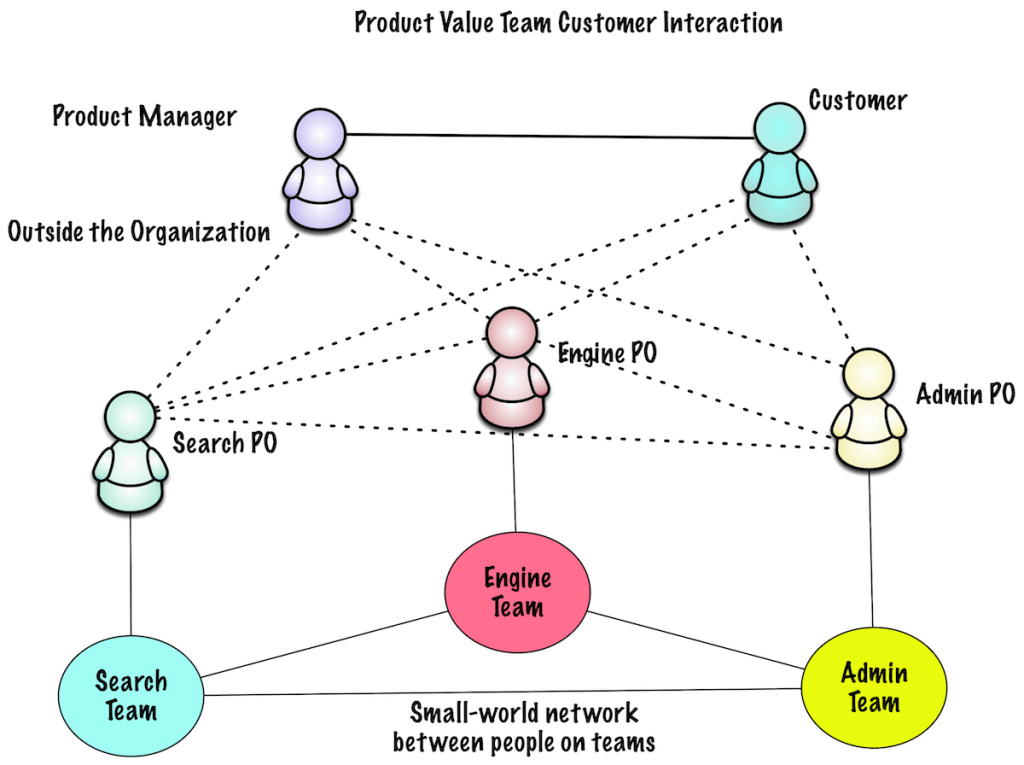Seeing the Close-to-the-Customer Conundrum
Especially when we use agile approaches, we want to be close to our customer. If you’ve ever had a chance to sit with a customer, you’ve learned how effectively (and fast!) the team and the customer learn from each other. And, too few teams have any access to any customers. Most of their customer information comes via a product owner, who learns from a product manager. Too often, the product manager learns from the salesperson.
That’s an awful lot of the telephone game. The delays might dwarf the actual time it takes to create and deliver this feature.

Is there a way to reduce the telephone game and the delays?
Maybe. It depends on the kind of product you’re creating—who your “customer” is. Here are some ideas:
Your customer is “down the hall”
If your customers are part of your organization, you might have more opportunities to engage them and invite them into your team, specifically to create a user story map and workshop stories. Maybe a map is enough, but that’s not my experience. I often discover we need to talk about what they do now and why that’s not working for them.
Ask your customers about their problems, not the features they want. When you start with problems, you might realize that solution is already in the code in some way.
Your customer might be down the hall, but they tend to be distant in what they think about and maybe even how they think.
When you invite these normally “distant” people into your world, you might be pleasantly surprised by how you start to work together.
Your customer is “out there”
When your customers are not part of your organization, we tend to have the customer conundrum—the salespeople are the primary conduit of information to and from the customers. We play the telephone game with all the delays as in the image above.

Even if you have an agile product value team, the primary contact tends to be the product manager with the customer, not the team.
If you have a direct sales force, that direct contact might be the salesperson, not even the product manager.
How do you bring the salespeople, product manager/product owners, and the team together?
Do something small.
Great salespeople discover needs and match the solutions they offer to the customers’ problems. That means that salespeople talk with customers on a regular basis.
When the salespeople talk in person with the customer, they often develop a deeper understanding of the problem than when they work just by phone.
The product managers also learn about the customers’ problems, especially if you have a mass market product. Or, if you sell through a distributor. In those cases, the salesperson might not know what the end-customer needs. The salesperson hears what the distributor wants to offer.
I often think—in simplistic terms—that salespeople match customer problems with producer’s products. And, that product managers want an early view of those problems to manage the product strategy.
Salespeople and product managers need to visit customers. So does the team, every so often, if only to avoid playing the telephone game.
What’s the smallest thing you can do to invite these people into the team or to have the team visit customers?
- Visualize the problem for everyone. Map the value stream so everyone can see the delays. Take the telephone image above, make it right for your organization and put hours, or worse, days on it. Show the work times and wait times. (Let me know if you want to see a value stream map.)
- Ask for help solving this problem. Explain that you don’t want to take more time to deliver features. You want to deliver features as fast as possible and know they are the right features.
- Generate a list of experiments and ask which experiment to try when. That will help everyone understand. For example, are there high-learning opportunities that will help the PO and the team learn, especially if they realize they don’t have to do any more in that feature set?
I don’t have “the” answer. I do know that the more I see a customer’s problem and environment, the easier it is for me to deliver value—the appropriate value, as fast as possible.
Seeing the game of telephone with a value stream map might help your team, and might help people see alternatives. In my experience, the closer a team is to the customer (or a representative customer), the better they can develop and release useful product.
Published on Java Code Geeks with permission by Johanna Rothman , partner at our JCG program. See the original article here: Seeing the Close-to-the-Customer Conundrum Opinions expressed by Java Code Geeks contributors are their own. |


